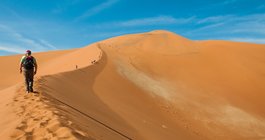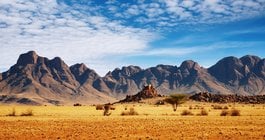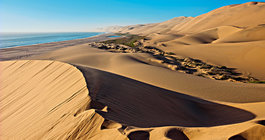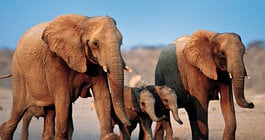Offer advantages
- an unconventional trail, touch a patch of land in three different countries
- for adrenaline and thrill lovers
- great focus on nature and adventure
- variety of landscapes: from the coast to the deserts
Namibia, Botswana i nad Zambezi Code: WDHNOL2
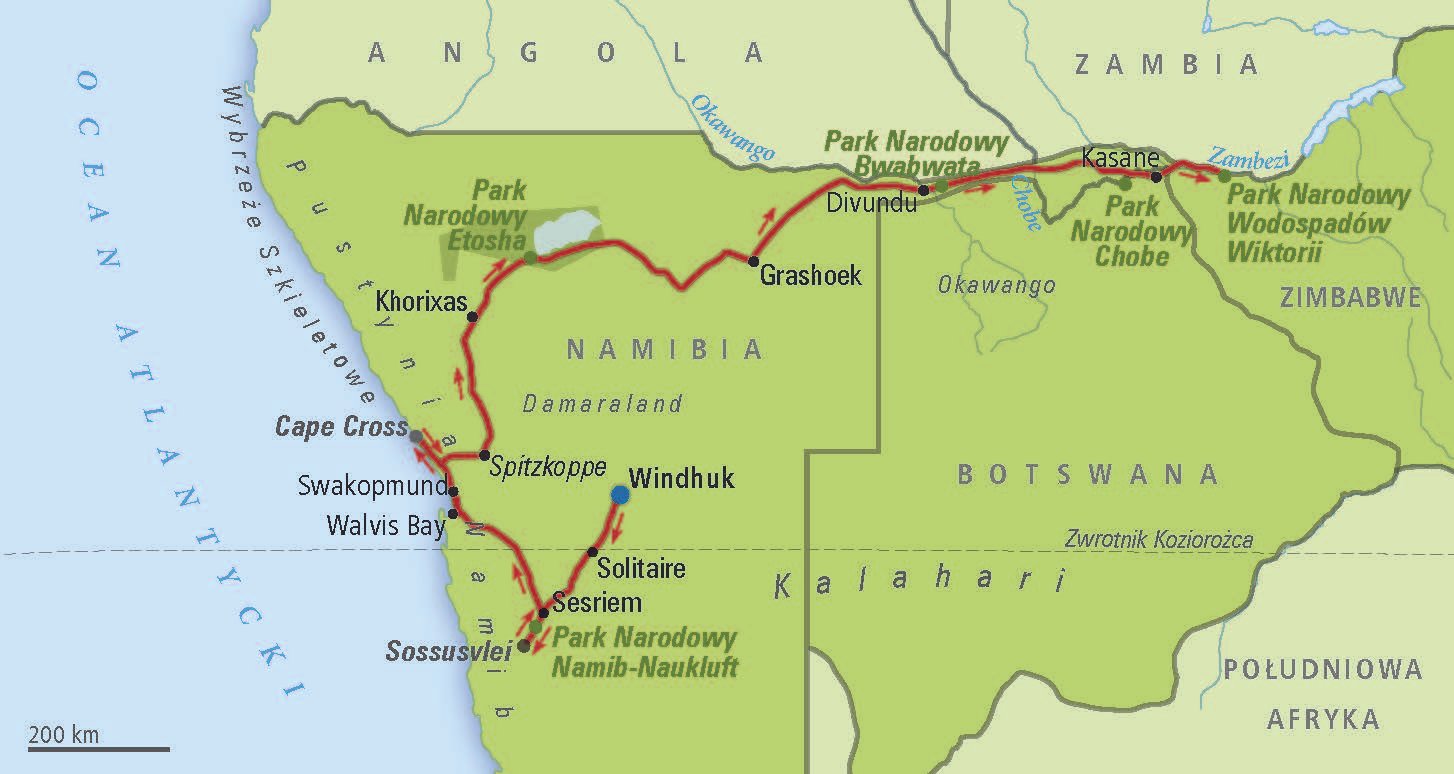
Namibia, Botswana i nad Zambezi
Code: WDHNOL2
Departure from Warsaw to Namibia.
2. DAY. WINDHUK
Arrival in the capital of Namibia - WINDHUK. Completion of visa formalities at the airport. Acquaintance with the leader of the expedition. Exchange of currency for a local one, purchase of a SIM card for those willing (no coverage possible in many places). Transfer to the capital. Check-in at the hotel and time to rest. Lunch. The program includes visiting the capital from the resident's side: rich and poor districts. Dinner. Overnight at the hotel. Route: approx. 45 km.
3. DAY. SESRIEM - NAMIB-SCIENCE NATIONAL PARK
Breakfast, check out and drive to SESRIEM, a small settlement on the outskirts of NAMIB-NAUKLUFT NATIONAL PARK. Drive on gravel roads through the desert landscape. Crossing the Tropic of Capricorn - a stop at the commemorative plaque. Stop at the Solitaire settlement. In Sesriem, descent to the bottom of the canyon carved by the Tsauchab River. It is one of the few places around the Namib Desert where water remains all year round. Lunch on the way. Evening drive to the campsite. Dinner in the camp and overnight in tents. The route is approx. 330 km.
4. DAY. SOSSUSVLEI - SESRIEM - SWAKOPMUND
Wake up before dawn and depart to admire the sunrise in SOSSUSVLEI. The Sossusvlei dunes are considered to be one of the largest in the world and have the original red color of the sand. Arrival at sunrise to the "dead valley" - one of the most unusual places in Namibia. The bottom of the basin is surrounded by mighty dunes and covered with the dry, dry stumps of acacia trees that have survived in this harsh desert scenery for many centuries. This contrast between the red dunes, the trough and the dry remnants of trees creates a surreal image, making it one of the most photogenic places in the world. Then, climb to the top of Namibia's highest dune and admire the views. Return to the camp in SESRIEM for breakfast. Check out. Departure towards Walvis Bay and continue along the Atlantic coast to SWAKOPMUND. This port town is an excellent example of well-preserved German colonial architecture. Walk around the city and free time. A choice of several optional activities (for an additional fee on site): a quad bike ride in the desert or a boat trip in search of pelicans and dolphins or a trip to the Sandwich Harbor. Lunch during the day. Accommodation and overnight at a hotel in Swakopmund. Route: approx. 500 km.
5. DAY. CAPE CROSS - SPITZKOPPE
Breakfast and check out. Drive from Swakopmund along the Atlantic coast towards CAPE CROSS. On the way, a stop at the wreckage of the Zeil minesweeper, which is the last ship to sink on the infamous Skeleton Coast. A visit to a cat colony and a stop at the characteristic cross. The first European to land in this part of the world was the Portuguese explorer Diego Cao (in 1486), who erected a stone cross in honor of King John II of Portugal, symbolically "occupying" the area (today at Cape Cross you can see a replica of the original). Arrival at the SPITZKOPPE hill, which dominates the flat plain. Accommodation at the campsite, dinner and overnight stay in a tent overlooking the mountain. Route: approx. 280 km.
DAY 6. SPITZKOPPE - NEAR KHORIXAS (DAMARALAND)
Breakfast overlooking the sunrise over the SPITZKOPPE Mountain. This mountain, called the Matterhorn of Africa, resembles the most beautiful peak of the Alps. It rises to a height of about 1,800 m above sea level. Check-out and departure from the camp. Drive through the land called DAMARALAND by the locals - the name comes from the ethnic group living in this area (Damara). A stop in the town of Uis, built near the former tin mine. Lunch. Next stop at the archaeological site of Twyfelfontein, a UNESCO World Heritage Site. It is one of the greatest sites of ancient rock art. A visit to the Damara open-air museum, the so-called Living Museum. The Damara people, along with the Bushmen, are considered to be one of the oldest tribes in Namibia of unknown origin. He is engaged in gathering, hunting and agriculture. Onward transfer to the campsite near the town of KHORIXAS, accommodation, dinner and overnight in tents. Route: approx. 240 km.
7th DAY. ETOSHA NATIONAL PARK
Breakfast at the camp, check-out and departure to the ETOSHA NATIONAL PARK. This is one of the largest and most spectacular African National Parks. Lunch on the way. Dinner and overnight in tents at the campsite inside the national park. For those willing to spend the evening and night at the pond while waiting for the animals coming to the watering site. Route: approx. 340 km.
8th DAY. ETOSHA NATIONAL PARK
Breakfast and check out. Safari in the ETOSHA NATIONAL PARK to search for animals. This park is home to 114 species of mammals, 340 species of birds, 110 different species of reptiles, 14 species of amphibian animals and, surprisingly, one species of fish. Etosha or "Great White Lake" covers 25% of the park's area. It is now a dry reservoir that was once filled with the water of the Kunene River, the bottom of which is mostly made of salt and clay. The reservoir is filled with water during the rainy season, but for a very short time and only during heavy downpours of rain. In the dry season, animals are fully dependent on man-made waterholes - they gather near water sources, where they are easy to meet. The plan of the dishes - traveling from watering to watering and observing animals. Lunch during the day - depending on how the day turns out, be it in the form of a picnic or at the campsite. Transfer to the camping, dinner and overnight in tents. In the evening, after dinner, you can wait for the animals at the pond overnight. Route: approx. 150 km.
9. DAY. GRASHOEK (GROOTFONTEIN AROUND)
After breakfast, morning game drive and departure from P. N. Etosha. Access to the site of the later campsite near the village of GRASHOEK. This is a campsite run by the San community and their culture will be the theme of the evening and the next morning. As they say about themselves, the San Bushmen are representatives of the first peoples of Africa. Many anthropologists consider San to be the last link between modern civilization and hunter-gatherer culture. They live in southern Africa for over 30 thousand. years, and the evidence of this are the numerous drawings on the rocks in Botswana, Namibia and South Africa. This is one of the most fascinating ethnic groups on earth, leading a nomadic lifestyle, their main occupation is hunting. Their natural way of life is disturbed by other groups of people settling in more and more places. The future of this tribe is not very bright. The last areas where they could lead their hunting lifestyle are taken over by farmers and mines. Lunch during the day (depending on the pace of the program implementation) outdoors, as a picnic. Evening dinner by the fire and overnight in tents. Route: approx. 390 km.
10. DAY. DIVUNDU (KAVANGO)
Breakfast at the camp, check-out and departure to the "thumb of Namibia", which is the easternmost belt of land approx. 450 km long. Drive to the road, which is the route of the largest population of elephants migrating from Chobe to Zambezi - to the vicinity of the town of DIVUNDU, located on the south-eastern bank of the Okavango River. The campsite is located close to the Bwabwata National Park, whose name in the local language means "sound of gurgling water". There is a great variety of species in the park. In addition to elephants and giraffes, this area also includes buffaloes, various species of antelope and hippos. The predatory species in Bwabwata are lions, leopards, cheetahs and crocodiles. Nevertheless, there is a species diversity among birds (over 350 species). Lunch on the way during the day. Accommodation and dinner at the camp, overnight in a tent. Route: approx. 410 km.
11. DAY. PARK NARODOWY BWABWATA
Breakfast at the campsite. Transfer to the BWABWATA NATIONAL PARK. A "mokoro" boat trip on the Kubango River (Okavango) in search of hippos, crocodiles and elephants. Afternoon relaxation by the river. Lunch and dinner at the campsite, overnight in tents.
12. DAY. KASANE (BOTSWANA)
Breakfast and departure from the campsite. Drive towards KASANE in Botswana. Crossing the border (should not exceed an hour). Kasane is the largest town in the region on the edge of the Chobe National Park. The park is famous for the largest concentration of elephants in the world. Lunch during the day. Accommodation in a camp. Dinner and overnight in a tent. Length of the route: approx. 450 km.
DAY 13. CHOBE NATIONAL PARK
Breakfast. A boat trip at the CHOBE NATIONAL PARK, on the Chobe River, where you can look for elephants, buffaloes, hippos and crocodiles. Lunch during the day. In the afternoon, return to the campsite and time to relax. Dinner and overnight.
14. DAY. VICTORIA NATIONAL WATERFALL PARK (ZIMBABWE)
Breakfast, check out and drive to the VICTORIA NATIONAL PARK in Zimbabwe (the distance to Victoria Falls is not that long, but the formalities at the border crossing may take some time.) Among the natural riches that Zimbabwe possesses, Victoria Falls are a real gem. It is an approx. 1,800 m wide curtain on the Zambezi River, which with a huge boom falls to a depth of approx. 120 m into a narrow ravine. In the rainy season, about 1.9 million liters of water per second fall from the rock threshold. The mist that arises during this decline is visible from a distance of about 60 km. Walk along the Victoria Falls. Accommodation at the lodge. Overnight. Route: approx. 90 km.
15. DAY. NATIONAL PARK OF VICTORIA FALLS
Breakfast at the lodge. THE NATIONAL PARK OF WATERFALLS OF VICTORIA offers a lot of suggestions for spending time actively. Optional (for an additional fee on site) participation in rafting on the Zambezi river, bungee jump, zip-line or a scenic helicopter flight over the waterfall. Return to the lodge and overnight.
DAY 16.
Breakfast, check out. Transfer to the airport. Departure to Poland.
17. DAY.
Arrival to Poland.
14 nights: 2 nights in hotels: (1 in Windhoek, 1 in Swokopmund) 2-person rooms with bathrooms • 10 nights in tents at campsites with sanitary facilities (running water) • 2 nights in a lodge (near Victoria Falls) 2-person. rooms with bathrooms • meals according to the program: 14 breakfasts, 12 lunches, 11 dinners • entry tickets to national parks according to the program • private 4x4 transfers • care of the Polish-speaking leader from the airport in Windhoek to transfer to the Victoria Falls airport • insurance KL and NW Itaka Complex
Namibia
Namibia to miejsce gdzie nie dotarła jeszcze masowa turystyka i gdzie przetrwały plemiona o fascynujących zwyczajach: Himba, Herero i Buszmeni. Bogaty świat fauny w Parku Narodowym Etosha, najstarsza pustynia świata – Namib, fantastyczne pomarańczowe wydmy i kolorowe miasteczka pozostałe po kolonizatorach to skarby czekające na odkrycie.

Windhoek • Sesriem • Namib-Naukluft National Park • Sossusvlei • Sesriem • Swakopmund • Cape Cross • Spitzkoppe • Khorixas Area (Damaraland) • Etosha National Park • Grashoek (Grootfontein Area) • Divundu (Kavango) • Bwabwata National Park • Kasane (Botswana) • Chobe National Park • Victoria Falls National Park (Zimbabwe)
Get ready for an extraordinary experience in Africa - this is a 4x4 vehicle trip to three different countries: Namibia, Botswana and Zimbabwe. Explore the oldest desert in the world - the Namib. Drive along the sinister and inhospitable Skeleton Coast, see the colony of cats at Cape Cross. Travel back in time and stroll through the colonial patch of Germany at Swakopmund. Spend the night in Spitzkoppe overlooking the Milky Way and the Southern Cross. Look for desert elephants in the Aba Huab River. Enter the animal kingdom of Etosha National Park. Cross the border into Botswana to travel down the Chobe River in search of the world's largest elephant population. Enter Zimbabwe to see the famous Victoria Falls. Cut yourself off from civilization and "feel" Africa for a while - in Europe people have watches, in Africa people have time! This trip is full of impressions! Towards adventure, out of range.
1. DAY. Departure from Warsaw to Namibia.
2. DAY. WINDHUK Arrival in the capital of Namibia - WINDHUK. Completion of visa formalities at the airport. Acquaintance with the leader of the expedition. Exchange of currency for a local one, purchase of a SIM card for those willing (no coverage possible in many places). Transfer to the capital. Check-in at the hotel and time to rest. Lunch. The program includes visiting the capital from the resident's side: rich and poor districts. Dinner. Overnight at the hotel. Route: approx. 45 km.
3. DAY. SESRIEM - NAMIB-SCIENCE NATIONAL PARK Breakfast, check out and drive to SESRIEM, a small settlement on the outskirts of NAMIB-NAUKLUFT NATIONAL PARK. Drive on gravel roads through the desert landscape. Crossing the Tropic of Capricorn - a stop at the commemorative plaque. Stop at the Solitaire settlement. In Sesriem, descent to the bottom of the canyon carved by the Tsauchab River. It is one of the few places around the Namib Desert where water remains all year round. Lunch on the way. Evening drive to the campsite. Dinner in the camp and overnight in tents. The route is approx. 330 km.
4. DAY. SOSSUSVLEI - SESRIEM - SWAKOPMUND Wake up before dawn and depart to admire the sunrise in SOSSUSVLEI. The Sossusvlei dunes are considered to be one of the largest in the world and have the original red color of the sand. Arrival at sunrise to the "dead valley" - one of the most unusual places in Namibia. The bottom of the basin is surrounded by mighty dunes and covered with the dry, dry stumps of acacia trees that have survived in this harsh desert scenery for many centuries. This contrast between the red dunes, the trough and the dry remnants of trees creates a surreal image, making it one of the most photogenic places in the world. Then, climb to the top of Namibia's highest dune and admire the views. Return to the camp in SESRIEM for breakfast. Check out. Departure towards Walvis Bay and continue along the Atlantic coast to SWAKOPMUND. This port town is an excellent example of well-preserved German colonial architecture. Walk around the city and free time. A choice of several optional activities (for an additional fee on site): a quad bike ride in the desert or a boat trip in search of pelicans and dolphins or a trip to the Sandwich Harbor. Lunch during the day. Accommodation and overnight at a hotel in Swakopmund. Route: approx. 500 km.
5. DAY. CAPE CROSS - SPITZKOPPE Breakfast and check out. Drive from Swakopmund along the Atlantic coast towards CAPE CROSS. On the way, a stop at the wreckage of the Zeil minesweeper, which is the last ship to sink on the infamous Skeleton Coast. A visit to a cat colony and a stop at the characteristic cross. The first European to land in this part of the world was the Portuguese explorer Diego Cao (in 1486), who erected a stone cross in honor of King John II of Portugal, symbolically "occupying" the area (today at Cape Cross you can see a replica of the original). Arrival at the SPITZKOPPE hill, which dominates the flat plain. Accommodation at the campsite, dinner and overnight stay in a tent overlooking the mountain. Route: approx. 280 km.
DAY 6. SPITZKOPPE - NEAR KHORIXAS (DAMARALAND) Breakfast overlooking the sunrise over the SPITZKOPPE Mountain. This mountain, called the Matterhorn of Africa, resembles the most beautiful peak of the Alps. It rises to a height of about 1,800 m above sea level. Check-out and departure from the camp. Drive through the land called DAMARALAND by the locals - the name comes from the ethnic group living in this area (Damara). A stop in the town of Uis, built near the former tin mine. Lunch. Next stop at the archaeological site of Twyfelfontein, a UNESCO World Heritage Site. It is one of the greatest sites of ancient rock art. A visit to the Damara open-air museum, the so-called Living Museum. The Damara people, along with the Bushmen, are considered to be one of the oldest tribes in Namibia of unknown origin. He is engaged in gathering, hunting and agriculture. Onward transfer to the campsite near the town of KHORIXAS, accommodation, dinner and overnight in tents. Route: approx. 240 km.
7th DAY. ETOSHA NATIONAL PARK Breakfast at the camp, check-out and departure to the ETOSHA NATIONAL PARK. This is one of the largest and most spectacular African National Parks. Lunch on the way. Dinner and overnight in tents at the campsite inside the national park. For those willing to spend the evening and night at the pond while waiting for the animals coming to the watering site. Route: approx. 340 km.
8th DAY. ETOSHA NATIONAL PARK Breakfast and check out. Safari in the ETOSHA NATIONAL PARK to search for animals. This park is home to 114 species of mammals, 340 species of birds, 110 different species of reptiles, 14 species of amphibian animals and, surprisingly, one species of fish. Etosha or "Great White Lake" covers 25% of the park's area. It is now a dry reservoir that was once filled with the water of the Kunene River, the bottom of which is mostly made of salt and clay. The reservoir is filled with water during the rainy season, but for a very short time and only during heavy downpours of rain. In the dry season, animals are fully dependent on man-made waterholes - they gather near water sources, where they are easy to meet. The plan of the dishes - traveling from watering to watering and observing animals. Lunch during the day - depending on how the day turns out, be it in the form of a picnic or at the campsite. Transfer to the camping, dinner and overnight in tents. In the evening, after dinner, you can wait for the animals at the pond overnight. Route: approx. 150 km.
9. DAY. GRASHOEK (GROOTFONTEIN AROUND) After breakfast, morning game drive and departure from P. N. Etosha. Access to the site of the later campsite near the village of GRASHOEK. This is a campsite run by the San community and their culture will be the theme of the evening and the next morning. As they say about themselves, the San Bushmen are representatives of the first peoples of Africa. Many anthropologists consider San to be the last link between modern civilization and hunter-gatherer culture. They live in southern Africa for over 30 thousand. years, and the evidence of this are the numerous drawings on the rocks in Botswana, Namibia and South Africa. This is one of the most fascinating ethnic groups on earth, leading a nomadic lifestyle, their main occupation is hunting. Their natural way of life is disturbed by other groups of people settling in more and more places. The future of this tribe is not very bright. The last areas where they could lead their hunting lifestyle are taken over by farmers and mines. Lunch during the day (depending on the pace of the program implementation) outdoors, as a picnic. Evening dinner by the fire and overnight in tents. Route: approx. 390 km.
10. DAY. DIVUNDU (KAVANGO) Breakfast at the camp, check-out and departure to the "thumb of Namibia", which is the easternmost belt of land approx. 450 km long. Drive to the road, which is the route of the largest population of elephants migrating from Chobe to Zambezi - to the vicinity of the town of DIVUNDU, located on the south-eastern bank of the Okavango River. The campsite is located close to the Bwabwata National Park, whose name in the local language means "sound of gurgling water". There is a great variety of species in the park. In addition to elephants and giraffes, this area also includes buffaloes, various species of antelope and hippos. The predatory species in Bwabwata are lions, leopards, cheetahs and crocodiles. Nevertheless, there is a species diversity among birds (over 350 species). Lunch on the way during the day. Accommodation and dinner at the camp, overnight in a tent. Route: approx. 410 km.
11. DAY. PARK NARODOWY BWABWATA Breakfast at the campsite. Transfer to the BWABWATA NATIONAL PARK. A "mokoro" boat trip on the Kubango River (Okavango) in search of hippos, crocodiles and elephants. Afternoon relaxation by the river. Lunch and dinner at the campsite, overnight in tents.
12. DAY. KASANE (BOTSWANA) Breakfast and departure from the campsite. Drive towards KASANE in Botswana. Crossing the border (should not exceed an hour). Kasane is the largest town in the region on the edge of the Chobe National Park. The park is famous for the largest concentration of elephants in the world. Lunch during the day. Accommodation in a camp. Dinner and overnight in a tent. Length of the route: approx. 450 km.
DAY 13. CHOBE NATIONAL PARK Breakfast. A boat trip at the CHOBE NATIONAL PARK, on the Chobe River, where you can look for elephants, buffaloes, hippos and crocodiles. Lunch during the day. In the afternoon, return to the campsite and time to relax. Dinner and overnight.
14. DAY. VICTORIA NATIONAL WATERFALL PARK (ZIMBABWE) Breakfast, check out and drive to the VICTORIA NATIONAL PARK in Zimbabwe (the distance to Victoria Falls is not that long, but the formalities at the border crossing may take some time.) Among the natural riches that Zimbabwe possesses, Victoria Falls are a real gem. It is an approx. 1,800 m wide curtain on the Zambezi River, which with a huge boom falls to a depth of approx. 120 m into a narrow ravine. In the rainy season, about 1.9 million liters of water per second fall from the rock threshold. The mist that arises during this decline is visible from a distance of about 60 km. Walk along the Victoria Falls. Accommodation at the lodge. Overnight. Route: approx. 90 km.
15. DAY. NATIONAL PARK OF VICTORIA FALLS Breakfast at the lodge. THE NATIONAL PARK OF WATERFALLS OF VICTORIA offers a lot of suggestions for spending time actively. Optional (for an additional fee on site) participation in rafting on the Zambezi river, bungee jump, zip-line or a scenic helicopter flight over the waterfall. Return to the lodge and overnight.
DAY 16. Breakfast, check out. Transfer to the airport. Departure to Poland.
17. DAY. Arrival to Poland.
BENEFITS: 14 nights: 2 nights in hotels: (1 in Windhoek, 1 in Swokopmund) 2-person rooms with bathrooms • 10 nights in tents at campsites with sanitary facilities (running water) • 2 nights in a lodge (near Victoria Falls) 2-person. rooms with bathrooms • meals according to the program: 14 breakfasts, 12 lunches, 11 dinners • entry tickets to national parks according to the program • private 4x4 transfers • care of the Polish-speaking leader from the airport in Windhoek to transfer to the Victoria Falls airport • insurance KL and NW Itaka Complex
NOTES:
Practical information
-
6.0
-
5.0
-
4.3
-
4.3
Wycieczkę oceniam bardzo pozytywnie! Dobrze zaplanowana trasa pokazująca różnorodność krajobrazów Namibii z pięknym zakończeniem nad wodospadami Wiktorii w Zimbabwe. Nasz wyjazd (grudzień 2024) (...)
Wycieczkę oceniam bardzo pozytywnie! Dobrze zaplanowana trasa pokazująca różnorodność krajobrazów Namibii z pięknym zakończeniem nad wodospadami Wiktorii w Zimbabwe. Nasz wyjazd (grudzień 2024) został wzbogacony (w stosunku do pierwotnego programu) o jeden dzień pobytu w Swakopmund. Był to bardzo udany dzień! Dwie wycieczki fakultatywne, z których można było skorzystać bardzo polecam. Poranny rejs po Atlantyku (uchatki, delfiny, pelikany i ostrygi w ramach lunchu) i popołudniowy wyjazd do Sandwich Harbour samochodami po wydmach (robi wrażenie jazda po piasku i to absolutnie nie po płaskim terenie) z widokiem na ocean pod wydmami! Cała nasza grupa uważała, że ten dzień powinien znaleźć się w przyszłych programach tej imprezy. Noclegi bez uwag. Wszystkie miejsca klimatyczne i każde miało jakiś swoje zalety. Noclegi w namiotach też raczej nie stanowiły większego dyskomfortu. Pola biwakowe Spitzkoppe i Mowani położone w rewelacyjnie pięknych okolicznościach przyrody!! Organizacja rozbijania obozowiska i przygotowywania posiłków bez zarzutu. Każdy miał swój przydzielony na cały pobyt namiot, torbę z pościelą (nawet były ręczniki). Obsługa rozstawiała stoły i krzesła turystyczne. Nasz opiekun Witek wielokrotnie jeździł z grupami po Namibii, więc doskonale zna lokalne warunki. Ma wiedzę o kraju, tylko czasami trzeba mu przypominać, żeby się nią podzielił. Jest otwarty i towarzyski. Nasza grupa liczyła 11 (przesympatycznych!!!) osób i podróżowaliśmy dwoma samochodami. Przejazdy długie, ale w moim odczuciu, mimo często monotonności krajobrazu, ciekawe i wygodne. Jedyną wadą wyjazdu był lot!! Nam zamieniono przewoźnika z Lufthansy na linie etiopskie. Nie chodzi o to, że same linie są gorsze, ale dodatkowe międzylądowania bardzo wydłużają podróż. Wracaliśmy z Viktoria Falls lecąc najpierw do Gaborone (stolica Botswany pod granicą z RPA, czyli oddalamy się od Europy) - międzylądowanie bez wysiadania z samolotu, potem oczekiwanie 3,5 godziny na przesiadce w Addis Abebie i potem lot do Warszawy z kolejnym międzylądowaniem w Wiedniu!! Trochę kosmos! Ogólnie jeszcze raz polecam tą wycieczkę!! Połowa noclegów w namiotach sprawia, że jest tańsza a nie gorsza!!!
-
6
-
5
-
5
-
5
-
5
Wycieczka bardzo ciekawa, choć męcząca. Pomysł zorganizowania jej w stosunkowo małej grupie jest bardzo dobry, gdyż wszystko przebiegało bardzo sprawnie. Długie przejazdy i spanie w namiotach (...)
Wycieczka bardzo ciekawa, choć męcząca. Pomysł zorganizowania jej w stosunkowo małej grupie jest bardzo dobry, gdyż wszystko przebiegało bardzo sprawnie. Długie przejazdy i spanie w namiotach na pewno nie są dla każdego , ale piękne widoki i możliwość podglądania zwierząt w ich naturalnym środowisku rekompensowały wszystkie niedogodności .Gorąco polecam.
-
6
-
3
-
4
-
3
-
3
Ciekawy i bogaty program. Przyroda zachwyca i pozostawia wspaniałe wspomnienia. Spanie pod namiotami stanowi ciekawą przygodę, a jedyne co bym poprawiła to dodała materace na łóżko polowe. (...)
Ciekawy i bogaty program. Przyroda zachwyca i pozostawia wspaniałe wspomnienia. Spanie pod namiotami stanowi ciekawą przygodę, a jedyne co bym poprawiła to dodała materace na łóżko polowe. Poprawi to bardzo komfort, a grupa o średniej wieku 50plus ma już swoje wymagania. Słaba strona wycieczki to zamiana biletu lotniczego na Ethiopian Airline z licznymi międzylądowaniami, co mocno wydłużało i tak długą podróż. Cała reszta była świetna, polowa kuchnia sprawdzała się doskonale i integrowała grupę. Do wyjaśnienia pozostaje rola Lidera. Nas prowadził Witek, miły i sympatyczny, ale nie pełnił on na pewno funkcji przewodnika w tradycyjnym ujęciu wycieczek objazdowych. Może wynika to też z formuły transportu w indywidualnych samochodach terenowych. My z wycieczki mamy tylko dobre wspomnienia i szukamy innych ofert z formuły NO LIMIT. Bardzo polecamy! Proszę jednak pamiętać, że to wyprawa dla tych co nie obawiają się trochę zmęczyć na zwiedzaniu! Obowiązkowo organizator powinien zostawić 2 dni nad oceanem, bo rejs z pelikanami to niezapomniana przygoda i mocna strona programu, my to zaliczyliśmy ze względu na zmianę lotów, a powinno być to stałym punktem programu.
-
6
-
4
-
6
-
5
-
5
Offer details
Twój wybór wczasów
Namibia
Namibia, Botswana i nad Zambezi
- send an enquiry
- callcenter.tel_pl
- +48 77 4476707
- mon-fri: 8-17









